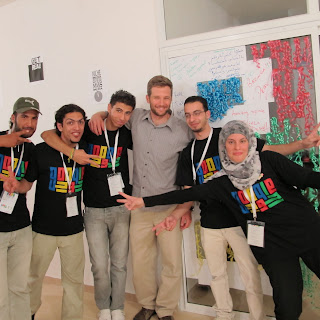YouTube in the Palestinian Territories
There are few areas in the world where the ubiquity of the web means more than in the Palestinian territories. In a place where conflict is a part of daily life, and land disputes prevent the kind of geographical freedom most of us take for granted, it’s platforms like YouTube that are allowing people to broadcast their ideas to the rest of the world—and to tell stories that aren’t being told by other media outlets.
A few weeks ago, as part of our efforts to broaden YouTube’s news content partnerships, I spent a week with some other Googlers in Gaza and the West Bank. I met with news organizations, bloggers, local officials, and young people—all of whom were eager to tell their stories on video. In the last month, over 16,000 videos have been uploaded to YouTube from the Palestinian territories, despite low access to 3G networks and broadband Internet. And of the more than 75,000 videos uploaded from the territories this year, 5,000+ were tagged as news and politics videos:
Sleepless in Gaza is an innovative 90-part (!) reality show on YouTube featuring six women who travel in the Palestinian territories and document their experiences. It drew such a following on YouTube that it’s now being optioned for TV series in the U.S.
- The Maan News Agency, the top online Palestinian news site, has begun uploading its video reports to YouTube to share with the world.
- Videos covering the March 15 demonstrations (which were held to demand unity between competing Palestinian political parties, Hamas and Fatah) saw many views on YouTube as conflict broke out between demonstrators and Hamas.
- The United Nations Relief and Works Agency (UNRWA) has a YouTube channel they use to tell the stories of Gazans they work with in schools and other projects.
- The Global Citizen Corps, a group of young bloggers organized by the international NGO Mercy Corps to do community service and media training, has a robust YouTube channel with videos made by young people telling the story of Gaza through their eyes.
- The Palestinian Broadcasting Corporation, once the state media outlet of President Abbas’ Fatah, has recently decided to hire an independent board of directors and produce content outside the influence of the government (on a model that might end up quite like PBS).
Meeting with bloggers in Ramallah
Meeting with bloggers in Gaza
It’s in Gaza (the part of the Palestinian territories that are run by Hamas) where media freedoms have a ways to go. Journalists told us they’d been jailed for writing articles critical of Hamas, and one news organization had their office broken into and computers stolen when their pages held criticism of the government. And, after growing to 1,200 members, the Global Citizen Corps caught the attention of the government and was disbanded by the organizers for a while to protect members.
But the people of the Palestinian territories want desperately to tell a story of the region that gets beyond stereotypes. The images we see in Western media, of a place fraught with conflict and despair, doesn’t tell the real story of the territories, they told us. Some Palestinian entrepreneurs even created a new travel website, highlighting the best there is to see in the region.
It’s been said before, but it’s true: it’s the young people in the Middle East who will make change. Seventy percent of the people in Gaza are under 30. In Israel, 30 percent of the population is under 14. Several bloggers told us they had relationships with Israeli youth on the Internet; their hope is that YouTube and other platforms will help them communicate beyond the seemingly intractable political battles between their leaders and start conversations that will lead to new opportunities for peace.

